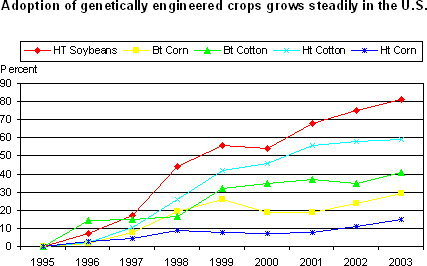
Adoption of Genetically Engineered Crops in the U.S.overviewU.S. farmers have adopted genetically engineered (GE) crops widely since their introduction in 1996, notwithstanding uncertainty about consumer acceptance and economic and environmental impacts. Soybeans and cotton genetically engineered with herbicide-tolerant traits have been the most widely and rapidly adopted GE crops in the U.S., followed by insect-resistant cotton and corn. This product summarizes the extent of adoption of herbicide-tolerant and insect–resistant crops since their introduction in 1996. Three tables devoted to corn, cotton, and soybeans cover the 2000-2003 period by State. See more on extent of adoption...
Data
include stacked traits. data
According to NASS, the States published in the following tables represent 81-82 percent of all corn planted acres (depending on the year), 89-90 percent of all soybean planted acres, and 81-83 percent of all upland cotton planted acres. See more on extent of adoption... The acreage estimates are subject to sampling variability because all operations planting GE varieties are not included in the sample. The variability for the 48 corn States, calculated by NASS using the relative standard error at the U.S. level, is 1.4-1.8 percent for all GE varieties (depending on the year), 1.7-2.1 percent for insect-resistant (Bt)-only varieties, 3.0-3.8 percent for herbicide-tolerant-only varieties, and 6.2-10.8 percent for stacked gene varieties. Variability for the 31 soybean States is 0.6-0.8 percent for herbicide-tolerant varieties, depending on the year. Variability for the 17 upland cotton States is 1.3-2.2 percent for all GE varieties, 4.6-5.1 percent for insect-resistant (Bt)-only varieties, 2.6-3.3 percent for herbicide-tolerant-only varieties, and 2.9-4.2 percent for stacked gene varieties. updates related resources
|
